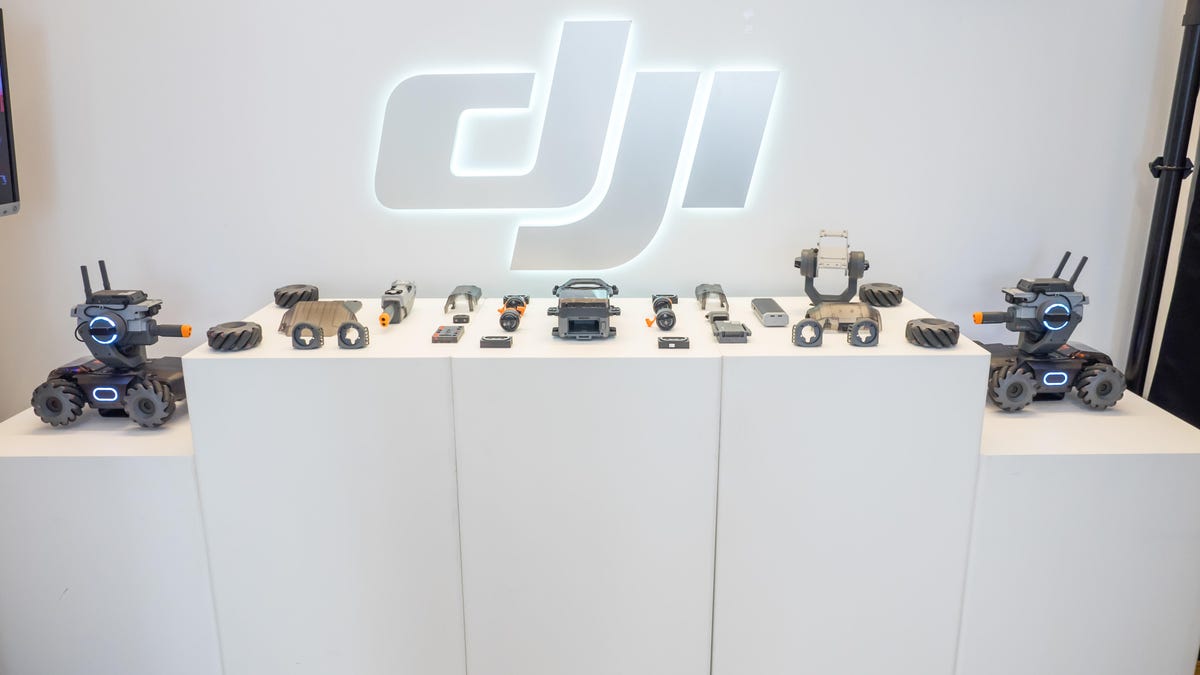
Meet the DJI RoboMaster S1
DJI enters another new product category with the RoboMaster S1, a DIY ground robot kit for consumers and STEM education.
46 pieces
The base $500 kit includes 46 parts, including microphones, cameras and IR and impact sensors.
DJI RoboMaster S1
There are 31 sensors in all, which is more than the company puts in its drones.
Motorin'
There are six brushless servo motors for high speed and accuracy.
Omnidirectional wheels
The motors and Mecanum wheels allow the S1 to move in any direction, not unlike DJI's drones do in the air.
Gimbal
The S1's first-person view camera, infrared beam and gel-bead blaster are on one of the company's motorized gimbals that are typically used for stabilizing cameras.
Blaster
The blaster can shoot an infrared beam at targets or the sensors on another S1.
Blaster beads
Or you can load the blaster with a cartridge you fill with water gel beads. They arrive dehydrated (right), but soaking them in water plumps them up for shooting (left). They're squishy and break apart sometimes on impact.
Gel beads
If you're familiar with Orbeez, that's essentially what these are. The blaster fire rate and angle pitch are limited to avoid injury and DJI will include eye protection just to be safe. They eventually dehydrate and can be vacuumed up for easy cleaning.
Ready for battle
The S1's target sensors are LED-lit so you can easily aim at them when you're in competition mode. They respond to being hit by the beads or IR.
Expansion
Though you get everything you need to build the S1 out of the box, there are six pulse width modulation (PWM) ports that allow you to add additional third-party accessories like speakers or LEDs.
Radio radio
The S1 can be controlled with a phone or tablet or with an optional controller paired with your phone or tablet.
FPV camera
Though the S1's main camera is for navigation and targeting, it you can record full HD-resolution video with it and take photos.
Entertainment modes
Though DJI mainly created it as an education tool, it's also built for play. Solo game modes allow you to practice your driving skills and taking aim at targets.
There are multiplayer options as well so you can race your friends and family or battle them in a Free-for-All mode which lets you shoot at other S1's with IR beams or the gel beads.
A view from the camera
Like flying a drone, it's best to drive the S1 by using the FPV camera feed on screen.
Vision markers
Included are a set of vision markers, such as the "1" you can see in this picture. In race modes you can use a set to act as checkpoints or use them for IR target practice.
In multiplayer battles, there's a Heart marker you can scan that virtually repairs your S1 if you get hit by an opponent. Similarly, a Mystery Bonus marker gives you one of four boosts to use against your competition: Dizziness, Electromagnetic Interference, Extreme Speed, and Invincibility.
Remote control
The controller isn't included, though maybe that's for the best. Steering is mainly done with left joystick while swiping with your right thumb on your tablet or phone screen controls the blaster/camera.
Controller connections
Your left index finger rests on the trigger.
Tap to shoot
Unlike DJI's other robots, capturing photos and videos is secondary to the STEM aspects of the S1.
Fully programmable
In the S1's app is access to coding tools. Under the Road to Mastery section, you'll find project-based courses on programming languages. Video tutorials and programming guides can be found under RoboAcademy.
Projects
Scratch 3.0 support
Drag-and-drop programming
Python
You can code in Python, too.
Controls
You can control the S1 with a phone or tablet on its own or paired with the optional controller or with a keyboard and mouse.
Controller + mouse = Win
I do not like the controller on its own. However, using a mouse to control the blaster and firing is a winning combo.
View from the top
Solo
With friends
DJI RoboMaster S1
The RoboMaster S1 is available in the US for $499 starting June 12. A "PlayMore Kit," which includes the dedicated controller, additional gel beads, one battery and a gel bead container, will be available for purchase in July. DJI doesn't have pricing on that kit yet, though. The S1 will also be available in China and Japan at launch, but no other regions were announced.

